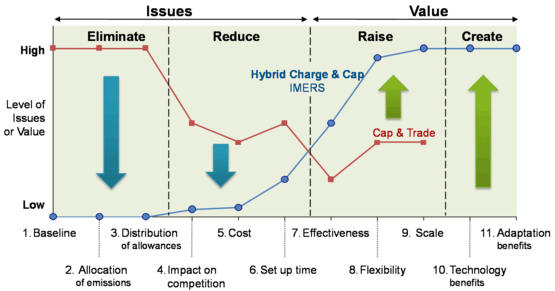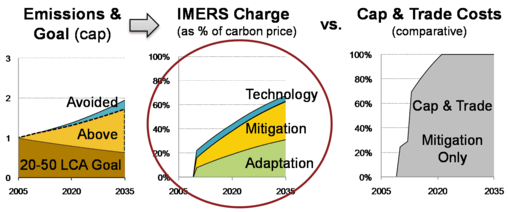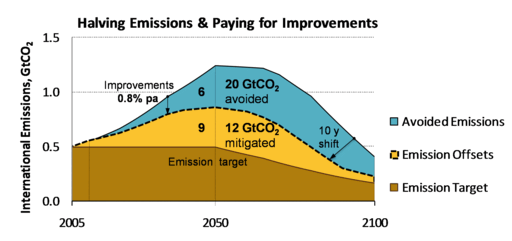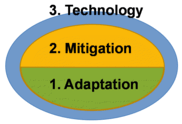Costs and Benefits
Combining mitigation with reducing the financing gap for adaptation to climate change through a cap-and-charge scheme is effective and efficient. It can be shown through a value innovation canvas.
Value Innovation of IMERS compared with Cap & Trade for Shipping
- IMERS is an efficient alternative to emission trading and delivers:
- Maximum efficiency with minimum rate
- Near-term emission reductions, AND stimulation of longer term technology innovation & transfer
- AND reduces the adaptation financing gap by $4bn/pa WITHOUT constraining economic growth!
The costs are as low as $1 for $1,000 of imported goods, the emissions are halved and developing countries will benefit from the $4bn financing contribution for adaptation to climate change.
The details are provided in the Value Innovation, Costs, and Benefits pages below.
Value Innovation
Benefits and Costs are directly related to Value Innovation of IMERS. It is perhaps best shown using the framework from the Blue Ocean Strategy.
Charge-and-Cap (IMERS) vs Cap-and-Trade for Shipping

The novel charge-and-cap scheme employed in IMERS is compared above with a traditional cap-and-trade emission trading scheme for shipping. The major value contributions in IMERS comes from:
- Eliminating:
- Baseline Data (need for it)
- Allocation of emissions
- Distribution of allowances
- Baseline Data (need for it)
- Reducing:
- Impact on Competition
- Cost (including participant's cost and effort)
- Set up time (down to 2 years)
- Impact on Competition
- Raising:
- Effectiveness
- Flexibility
- Scale (from Regional to Global)
- Effectiveness
- Creating:
- Technology financing (for near- and long-term improvements)
- Financial Contributions to Adaptation to Climate Change
- Technology financing (for near- and long-term improvements)
Please note that our hybrid scheme is also known under two other names: cap-and-charge, charge-cap-and-trade.
Scheme Costs
Minimizing costs is crucial as international transport is key for trade and sustainable development. IMERS, a cap-and-charge scheme, will be significantly cheaper than cap-and-trade.
Selecting an ambitious yet affordable scheme & cap

Importantly, IMERS will simultaneously deliver significant innovative financing for adaptation to climate change in developing countries and financing for technology R&D and transfer!
The proposed scheme is economically efficient and operational costs are kept low thanks to a centralized approach. The overall impact on end user prices is estimated at $1 for $1,000 of imported goods, i.e. around 0.1% (equivalent to increase of shipping costs by around 3%).
This is contrasted with the high costs for a hypothetical Cap-and-trade for shipping. For the above comparison, we have used the just announced parameters for the EU ETS for 2013-2020 (see section on Auctioning: 60% auctioning from 2013 onwards, etc).
The level of charge depends on ambition defined by a notional emission cap. Even for an ambitious 20-50 cap from 2005 the IMERS approach is easily affordable while delivering mitigation, adaptation and technology funding (as shown above).
IMERS Cost Impact
We calculate that using a harmonized charge of under $10/tCO2, would suffice from 2010-2012 (equivalent to 30% of the forward carbon price of around $30/tCO2). This translates to $30/ton of fuel.
Detailed cost calculations and impact are provided in the table below for charges as % of carbon (CO2) market price, and impact on: fuel prices, shipping costs, and end customer.
|
Year |
% of C$ |
$/t fuel* |
Shipping $ |
Customer |
|
2012 |
30% |
$27 |
2% |
< 0.1% |
|
2020 |
46% |
$42 |
3% |
< 0.1% |
|
2035 |
70% |
$64 |
5% |
< 0.2% |
*For market data: $30/tCO2, $500 t/HFO.
Finally, administrative costs for the participating ship managers is very low. The total reporting effort is expected to be under 20 minutes per month for the submission of a consolidated report on fuel used by all the ships under management. If that approach proved unworkable for some ship managers or sections of shipping, an alternative approach based on the Bunker Delivery Notes (as required by MARPOL Annex VI) will also deliver low cost.
In summary, the hybrid scheme can be ambitious and affordable, while being achievable in short-term.
Benefits
We estimate that the combination of the market mechanism, additional technical and operational industry improvements, including the mitigation programmes paid for by a portion of the funds raised, will reduce the emissions by 0.5% to 0.8% annually till 2050 (dependent on the split of funds). The total emission impact till 2100 would be more than halved due to the reduced growth and the effect of bringing forward step changes by up to 10 years.
Simultaneously, developing countries will benefit from the adaptation financing and the shipping industry from the improvements in the sector.
- Benefit details are provided for:
- Environment
- Developing countries
- Shipping
Environment
Environmental benefits are measured in emissions avoided within and mitigated outside of the shipping sector, expressed in GtCO2.
The table and picture below provide the estimates of the significant benefits of IMERS.
|
By 2050, GtCO2 |
2051-2100, GtCO2 |
|
|
Emission avoidance: |
12 |
40 |
|
Emission mitigation (offset): |
18 |
24 |
|
Total environment: |
30 |
64 |
The picture shows the mid-2007 calculations. In Dec 2007 the IMO estimated the emissions at around 1GtCO2 for 2005, effectively doubling the previous estimate. Therefore the numbers should be multiplied by 2.

Developing Countries
Benefits to developing countries start with the common but differentiated responsibility principle comprehensively fulfilled, at both collection and distribution points.
The scheme is also
- both global (as per the IMO)
- and differentiated (as per the UNFCCC) in that the regime applies only to the emissions associated with cargo destined for Annex I Parties (in the current regime)

- The benefit areas for developing countries include (assuming that only emissions attributable to Annex I countries are in scope):
- Adaptation: Major funding for adaptation to climate change in developing countries
- Estimated at $2.5bn+ per annum (assuming equal split of funds between mitigation and adaptation, and carbon market price of $30/tCO2)
- This innovative approach to reduce the gap in financing of adaptation seems essential. Thus far the international community has promised approximately $200m for adaptation measures, but the required funds are estimated at tens of $billions (circa 100:1 gap ratio)
- Estimated at $2.5bn+ per annum (assuming equal split of funds between mitigation and adaptation, and carbon market price of $30/tCO2)
- Mitigation: Significantly increased demand for REDD, CDM & JI projects
- The additional global demand estimated in excess of 150MtCO2 in 2012
- The current oversupply of CDM/JI drives the prices down, while lack of major funding does not stimulate REDD
- The additional global demand estimated in excess of 150MtCO2 in 2012
- Technology benefits
- Significant increase in financing of maritime R&D, estimated at $1bn (stimulation of innovation globally)
- Transfer of technologies to developing countries
Shipping
- The business benefits of IMERS include:
- Hassle free solution for CO2 emissions with minimal administration costs (no allowances to manage, no individual cap to comply with, services provided, no set-up costs)
- No impact on international competitiveness (level playing due to global implementation)
- Increased cash flow (EBIDTA) as a result of improved operations and reduced fuel
- Reduced risk of fuel disputes
- Compliance easily verifiable (via fuel and voyage data, and analytical tools)
- Reduced risk of multiple regulations
- Benefits of better image (clean transport, social responsibility)
